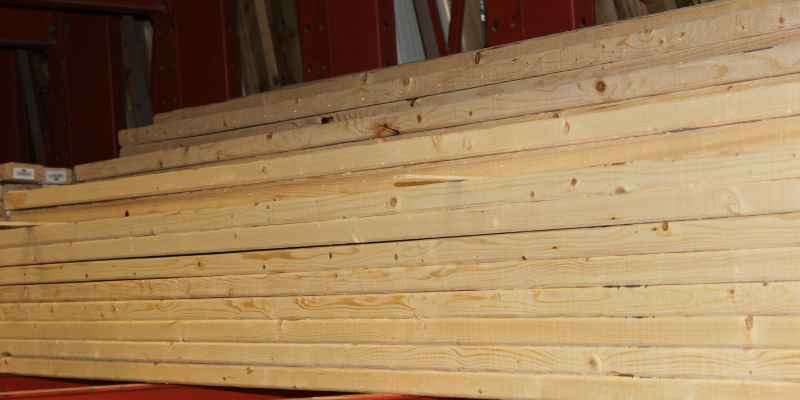8/4 wood is 2 inches thick. This dimension is a standard measurement for lumber thickness.
When working on woodworking projects, it is essential to understand the dimensions of the materials being used. In the case of 8/4 wood, the thickness is precisely 2 inches. This thickness is commonly used for various applications, such as furniture making, cabinetry, and other woodworking projects.
Knowing the exact thickness of the wood you are working with is crucial for ensuring precise and accurate results in your creations. By being aware of the standard measurement of 8/4 wood, you can effectively plan and execute your woodworking projects with confidence and precision.
Understanding Lumber Measurement
Lumber thickness can sometimes be confusing due to the various measurement systems used. One common way to measure wood thickness is through fractions like 8/4. Let’s delve into what this measurement means and how it relates to the actual thickness of wood.
What Is 8/4 Wood?
In the world of lumber, 8/4 wood refers to a thickness measurement. The “8” in 8/4 indicates the number of quarters of an inch, while the “4” denotes the number of quarters equal to an inch. Simplifying this, 8/4 wood is equivalent to 2 inches in thickness.
How Is Lumber Thickness Measured?
Lumber thickness is measured in inches or fractions of an inch. The 8/4 measurement system is based on quarters of an inch, where each number represents a quarter of an inch. Therefore, 8/4 wood translates to 2 inches thick in reality.
Impact Of Thickness On Woodworking
The thickness of wood in woodworking is crucial, and 8/4 wood is typically 2 inches thick, making it suitable for various projects. Its substantial thickness provides durability and stability, making it ideal for furniture, flooring, and other woodworking applications.
The Impact Of Thickness On Woodworking
When it comes to woodworking, the thickness of the wood plays a significant role in the overall outcome of a project. It affects not only the design and aesthetics but also the practicality and durability of the finished product. One commonly used measurement for wood thickness is the 8/4 classification, which refers to the thickness in lumber inches. Understanding the impact of this thickness is crucial for any woodworker.
Challenges Of Working With Thick Wood
Working with thick wood presents several challenges that woodworkers need to be aware of. These challenges include:
- Maneuverability: Thick wood is heavier and bulkier, making it more challenging to move around and handle during the woodworking process. It may require additional manpower or assistance to work with.
- Machine Compatibility: Thick wood often requires specialized machinery or blades to cut through effectively. Standard equipment may not be suitable, resulting in a need for additional tools or modifications.
- Increased Cutting Time: Due to the greater thickness, cutting through thick wood takes longer compared to working with thinner materials. Patience and precision are key for achieving desirable results.
- Drying and Warping: Thick wood takes longer to dry, increasing the risk of warping or cracking. Proper drying techniques and moisture control are essential to mitigate these issues.
Benefits Of Using 8/4 Wood
Despite the challenges, using 8/4 wood offers several benefits that make it a popular choice for woodworking projects:
- Strength and Durability: 8/4 wood is thicker, resulting in a sturdier and more durable end product. It is ideal for projects that require strength, such as furniture or structural components.
- Enhanced Design Options: The increased thickness allows for more creativity in design, enabling intricate carvings, deep chamfers, and elegant joinery techniques.
- Longevity: Thicker wood has a longer lifespan, making it suitable for projects that are meant to withstand the test of time. It can resist wear, tear, and other external factors better than thinner materials.
- Easier Sanding and Finishing: 8/4 wood provides a greater surface area to work with, allowing for easier and more efficient sanding and finishing. This results in a smoother and more polished final product.
Understanding the impact of thickness on woodworking and the specific challenges and benefits of using 8/4 wood is crucial for any woodworker. By taking these factors into consideration and adapting their techniques accordingly, woodworkers can achieve exceptional results in their projects.
Tips For Cutting And Handling 8/4 Wood
When it comes to working with 8/4 wood, it’s important to have the right tools and techniques in order to achieve clean and precise cuts. The thickness of 8/4 wood, which is equivalent to 2 inches, requires specific considerations to ensure successful woodworking projects. In this section, we’ll discuss the tips for cutting and handling 8/4 wood, including selecting the right tools and proper cutting techniques.
Selecting The Right Tools
When working with 8/4 wood, it’s essential to have the appropriate tools to handle its thickness. Here are some tools that can aid in cutting and handling thick lumber:
- Circular Saw: A circular saw with a ripping blade is ideal for making straight cuts in 8/4 wood.
- Table Saw: A table saw equipped with a ripping blade can also be used to cut 8/4 wood. It provides stability and precision for clean cuts.
- Bandsaw: A bandsaw is another great tool for cutting thicker lumber. With its wide blade and adjustable fence, it allows for intricate and curved cuts in 8/4 wood.
Proper Techniques For Cutting Thick Lumber
When cutting 8/4 wood, it’s important to follow proper techniques to ensure accurate and safe cuts. Here are some techniques to consider:
- Measure Twice, Cut Once: Before making any cuts, double-check your measurements to avoid wastage and ensure precise cuts.
- Use Multiple Passes: When using a circular saw or table saw, it’s recommended to make multiple passes with gradually increasing depth. This helps prevent the blade from binding and ensures a smooth cut.
- Secure the Wood: Use clamps or a wood vise to secure the 8/4 wood firmly in place before making any cuts. This provides stability and reduces the risk of accidents.
- Wear Safety Gear: Always wear safety goggles, ear protection, and gloves when cutting thick lumber. This protects you from flying debris and potential injuries.
By selecting the right tools and following proper techniques, cutting and handling 8/4 wood can be a manageable task. Remember to prioritize safety and precision throughout your woodworking projects for optimal results.
Common Uses Of 8/4 Wood
Furniture makers often utilize 8/4 wood due to its thickness giving a substantial feel, ideal for creating durable and long-lasting furniture pieces.
8/4 wood offers carpenters and construction professionals a sturdy material for structural elements like posts, beams, and framing due to its robust density.
Purchasing And Sourcing 8/4 Wood

When it comes to purchasing and sourcing 8/4 wood, it’s essential to find reliable suppliers and consider specific factors to ensure you’re getting the right type of lumber for your project. Let’s delve into the key aspects of acquiring 8/4 wood.
Finding Suppliers For Thick Lumber
When looking for suppliers, it’s crucial to find a reputable source that provides high-quality 8/4 wood. Local lumberyards, specialty wood suppliers, and online retailers are common places to source this material. By exploring different options, you can compare the quality, pricing, and available species to find the best fit for your project.
Considerations For Purchasing 8/4 Wood
Before making a purchase, there are key considerations to keep in mind. It’s important to assess the wood’s moisture content, as well as inspect the lumber for defects such as knots, warping, or cracks. Additionally, understanding the specific requirements of your project – including the wood species, grain pattern, and intended use – will guide your purchasing decision, ensuring you select the most suitable 8/4 wood for your needs.
Understanding Lumber Grades And Species
8/4 wood is typically 2 inches thick, making it a sturdy choice for woodworking projects. Understanding lumber grades and species can help you select the right wood for your specific needs. By knowing the thickness of 8/4 wood and its characteristics, you can make informed choices for your woodworking projects.
Grading Systems For Thick Lumber
When it comes to evaluating the quality of thick lumber, it’s essential to understand the grading systems used in the lumber industry. The grading system determines the quality and appearance of the wood, aiding in decision making for specific woodworking projects. Understanding the grading systems for thick lumber is crucial for selecting the right quality and appearance for your woodworking needs.
Popular Wood Species In 8/4 Thickness
In addition to grades, the wood species play a significant role in the characteristics and properties of thick lumber. Different wood species offer varying levels of hardness, color, and grain patterns, impacting the final look and durability of your project. Knowing the popular wood species in 8/4 thickness will guide you in choosing the most suitable material for your woodworking project.
– Grading systems help in evaluating the quality and appearance of thick lumber.
– The grading system determines the suitability of the lumber for specific woodworking projects.
– Understanding different grading systems aids in selecting the right quality and appearance for your projects.
– Different wood species offer varying levels of hardness, color, and grain patterns.
– The choice of wood species impacts the final look and durability of your woodworking project.
– Knowing the popular wood species in 8/4 thickness guides you in choosing the most suitable material for your project.
Cost And Maintenance Considerations
When it comes to 8/4 wood, understanding the cost implications and maintenance requirements is crucial for making informed decisions. Let’s delve into the factors affecting the cost of 8/4 wood and the essential aspects of maintenance and care for thick lumber.
Factors Affecting The Cost Of 8/4 Wood
- Wood Species: Different species have varying prices based on availability and demand.
- Grade of Wood: Higher grades command higher prices due to better quality and appearance.
- Sourcing: Local vs exotic woods can significantly impact the cost.
- Supply and Demand: Market fluctuations influence pricing.
- Finish and Treatment: Pre-finished or treated wood may cost more upfront.
Maintenance And Care For Thick Lumber
- Regular Inspection: Check for cracks, warping, or signs of decay.
- Cleaning: Use a mild detergent and water to keep the wood clean.
- Protective Coatings: Apply sealants or finishes to protect the wood from moisture and UV rays.
- Avoid Moisture: Keep 8/4 wood away from prolonged exposure to moisture to prevent rot.
- Proper Storage: Store lumber in a dry and ventilated area to maintain its quality.
Conclusion And Final Thoughts
The standard thickness of 8/4 wood is 2 inches. It is commonly used in woodworking projects for its durability and strength.
The Versatility Of 8/4 Wood
8/4 wood, which is approximately 2 inches thick, offers a wide range of applications due to its versatility. Whether you are a professional woodworker or a DIY enthusiast, this lumber thickness provides strength and stability, making it suitable for various projects.
One of the main advantages of using 8/4 wood is its durability. The thickness of this lumber ensures that the finished product is sturdy and long-lasting. It can withstand heavy loads and is less prone to warping or sagging over time.
In addition to its durability, 8/4 wood is also known for its aesthetic appeal. The thickness allows for deeper and more pronounced grain patterns, enhancing the natural beauty of the wood. This makes it an excellent choice for furniture making, as well as cabinetry, flooring, and other decorative elements.
Furthermore, 8/4 wood provides ample material to work with. Whether you need to shape, carve, or join the wood, this thickness offers enough substance to bring your creative ideas to life. It allows for intricate detailing and provides stability during the fabrication process.
Exploring The Potential Of Thick Lumber
Thick lumber, such as 8/4 wood, opens up a world of possibilities for woodworking projects. With its substantial thickness, this type of wood can be used for a variety of purposes.
One area where thick lumber shines is in structural applications. Whether you are building a sturdy table, constructing a durable bookshelf, or creating a robust outdoor deck, the thickness of the wood ensures stability and strength.
Additionally, 8/4 wood is an excellent choice for projects that require deep cuts and shaping. The ample thickness allows for more intricate designs and allows woodworkers to bring their creativity to the forefront. It is particularly useful for sculpting, carving, and other detailed woodworking techniques.
Moreover, the thickness of 8/4 wood provides insulation properties, making it suitable for projects that require thermal or soundproofing elements. From creating interior doors to designing wall panels, this lumber thickness can help improve the overall comfort and acoustics of a space.
In conclusion, 8/4 wood, with its 2-inch thickness, offers durability, aesthetic appeal, and versatility in various woodworking projects. Its strength and stability make it an ideal choice for structural applications, while its thickness allows for intricate detailing and shaping. Whether you are a professional woodworker or a DIY enthusiast, the potential of thick lumber like 8/4 wood is worth exploring.

Frequently Asked Questions On How Thick Is 8/4 Wood
Is 8 4 Lumber Actually 2 Inches?
Yes, 8/4 lumber is actually 2 inches thick.
How Big Is A 4×8 Wood?
A 4×8 piece of wood is 4 feet wide and 8 feet long, commonly used for construction.
What Does 8 4 Walnut Mean?
8/4 walnut refers to the thickness of the lumber, specifically 8/4 translates to 2 inches.
What Is The Standard Thickness Of Wood?
Standard wood thickness is typically 1 inch or 2 inches thick for various woodworking applications.
Conclusion
Understanding the thickness of 8/4 wood is essential for woodworking projects. Knowing its actual dimensions can save time and effort. Remember, 8/4 wood is approximately 2 inches thick in real measurement. This knowledge will help you select the right material for your next woodworking endeavor.


